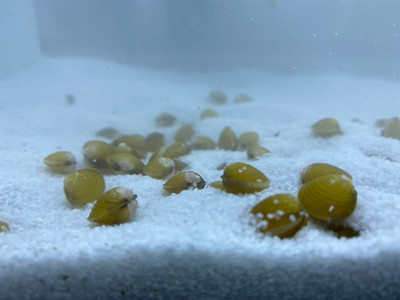Mini Yellow Freshwater Clams
Posted by Max Gandara on on 25th May 2025
Mini Yellow Freshwater Clams: Nature’s Tiny Water Filters for Your Aquarium
If you’re looking for a unique, low-maintenance invertebrate that quietly benefits your aquarium ecosystem, look no further than the Mini Yellow Freshwater Clam (Corbicula javanicus). These small bivalves don’t just sit pretty — they actively filter your water and support tank stability in subtle but meaningful ways.
Let’s take a deeper dive into the care, benefits, and things to watch for with these underrated aquatic gems.
? What Are Mini Yellow Freshwater Clams?
Mini Yellow Clams are a species of Asian freshwater bivalves known for their compact size and smooth, yellow-tinted shells. Reaching just about 0.5–1 inch in size, they are peaceful and non-invasive, making them a great choice for community tanks and shrimp setups.
Their calm, sedentary nature makes them easy to overlook — but beneath the substrate, they’re working hard 24/7.
? The Benefits of Keeping Mini Yellow Clams
✅ 1. Natural Water Filtration
These clams are filter feeders, meaning they consume microscopic particles suspended in the water column — including detritus, uneaten food, and algae. This contributes to clearer, cleaner water and improved nutrient balance, especially in low-flow tanks.
✅ 2. Low Bioload
Unlike many tank mates, clams produce very little waste, meaning they won't contribute much to your bioload — ideal for nano tanks or delicately balanced ecosystems.
✅ 3. Compatible with Shrimp and Peaceful Fish
Mini Yellow Clams don’t hunt, fight, or compete for territory. They’re perfect companions for shrimp, snails, small rasboras, tetras, or peaceful bettas.
⚙️ Care Requirements
While they’re fairly easygoing, clams do have a few specific care needs to thrive long-term.
? Water Parameters:
-
Temperature: 68–78°F (20–26°C)
-
pH: 6.8–7.8
-
Hardness: Moderate (calcium helps shell strength)
-
TDS: 150–300 ppm
⚠️ Avoid soft or acidic water, which can weaken their shells and shorten lifespan.
? Substrate:
They love to bury themselves in fine sand or smooth gravel. This helps them feel secure and improves their ability to feed.
? Diet:
While they primarily filter-feed, in clean tanks with little suspended matter, you may need to supplement with liquid invertebrate food like:
-
Phytoplankton
-
Micro crustacean blends
-
Fine powdered shrimp food
? Things to Watch For
-
Dead Zones: Like all bivalves, dead or dying clams can release ammonia. Always monitor your tank's nitrogen cycle and remove any clam that hasn’t opened or responded for several days.
-
Oxygen Levels: Clams require well-oxygenated water — poor flow or excessive organics can lead to suffocation.
-
Copper Sensitivity: Avoid all copper-based medications or plant fertilizers, which are toxic to clams and other inverts.
When purchasing, ensure they are:
-
Actively responsive (closing when touched)
-
Intact and not cracked
-
From clean, disease-free tanks
? Final Thoughts
The Mini Yellow Freshwater Clam is a quiet worker — not flashy, but endlessly useful. Ideal for aquarists who appreciate natural filtration, low-maintenance livestock, and a touch of the unusual, these clams are a hidden gem in the aquarium world.
With proper care, they can live for 1–2 years, silently helping your tank sparkle while requiring very little in return.

